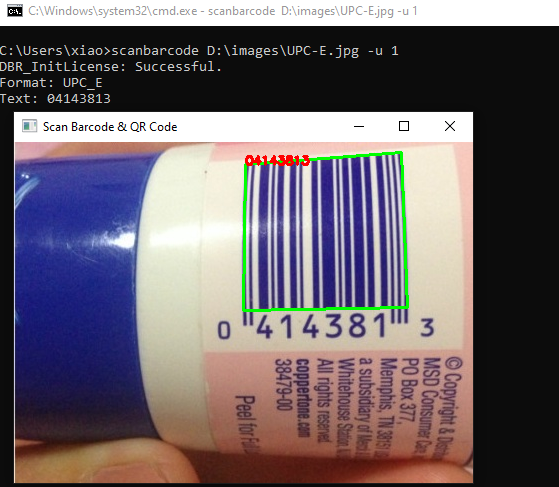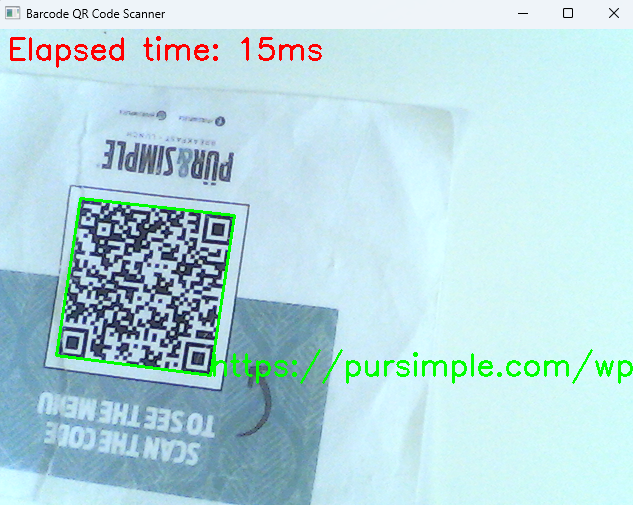This project provides a CPython binding to the Dynamsoft C/C++ Barcode Reader SDK v9.x. It demonstrates how to build a Python 1D/2D barcode SDK package for Windows, Linux and macOS from scratch. Beyond desktop PCs, it's also compatible with embedded and IoT devices such as Raspberry Pi and Jetson Nano. You are free to customize the Python API for Dynamsoft Barcode Reader to suit your specific needs.
Note: This project is an unofficial, community-maintained Python wrapper for the Dynamsoft Barcode SDK. For those seeking the most reliable and fully-supported solution, Dynamsoft offers an official Python package. Visit the Dynamsoft Capture Vision Bundle page on PyPI for more details.
- Get a 30-day FREE trial license to activate the SDK.
- Install the SDK via
pip install dynamsoft-capture-vision-bundle.
| Feature | Unofficial Wrapper (Community) | Official Dynamsoft Python Barcode SDK |
|---|---|---|
| Support | Community-driven, best effort | Official support from Dynamsoft |
| Documentation | README only | Comprehensive Online Documentation |
| API Coverage | Limited | Full API coverage |
| Feature Updates | May lag behind the official SDK | First to receive new features |
| Compatibility | Limited testing across environments | Thoroughly tested across all supported environments |
| OS Support | Windows, Linux, macOS | Windows, Linux, macOS |
- Python 3.x
To show UI, you need to install the OpenCV package:
pip install opencv-python$ scanbarcode <file-name> -l <license-key>
# Show the image with OpenCV
$ scanbarcode <file-name> -u 1 -l <license-key>-
Create a source distribution:
python setup.py sdist
-
setuptools:
python setup_setuptools.py build python setup_setuptools.py develop # Copy libraries to barcodeQrSDK folder -
scikit-build:
python setup.py build python setup.py develop # Copy libraries to barcodeQrSDK folder -
Build wheel:
pip wheel . --verbose # Or python setup_setuptools.py bdist_wheel # Or python setup.py bdist_wheel
-
Console App
import barcodeQrSDK # set license barcodeQrSDK.initLicense("LICENSE-KEY") reader = barcodeQrSDK.createInstance() results, elapsed_time = reader.decodeFile("IMAGE-FILE") for result in results: print(result.format) print(result.text) print(result.x1) print(result.y1) print(result.x2) print(result.y2) print(result.x3) print(result.y3) print(result.x4) print(result.y4)
-
Video App
import barcodeQrSDK import numpy as np import cv2 import json g_results = None def callback(results, elapsed_time): global g_results g_results = (results, elapsed_time) def run(): # set license barcodeQrSDK.initLicense("LICENSE-KEY") # initialize barcode scanner scanner = barcodeQrSDK.createInstance() params = scanner.getParameters() # Convert string to JSON object json_obj = json.loads(params) # json_obj['ImageParameter']['ExpectedBarcodesCount'] = 999 params = json.dumps(json_obj) ret = scanner.setParameters(params) scanner.addAsyncListener(callback) cap = cv2.VideoCapture(0) while True: ret, image = cap.read() if image is not None: scanner.decodeMatAsync(image) if g_results != None: print('Elapsed time: ' + str(g_results[1]) + 'ms') cv2.putText(image, 'Elapsed time: ' + str(g_results[1]) + 'ms', (10, 30), cv2.FONT_HERSHEY_SIMPLEX, 1, (0, 0, 255), 2) for result in g_results[0]: x1 = result.x1 y1 = result.y1 x2 = result.x2 y2 = result.y2 x3 = result.x3 y3 = result.y3 x4 = result.x4 y4 = result.y4 cv2.drawContours(image, [np.int0([(x1, y1), (x2, y2), (x3, y3), (x4, y4)])], 0, (0, 255, 0), 2) cv2.putText(image, result.text, (x1, y1), cv2.FONT_HERSHEY_SIMPLEX, 1, (0, 255, 0), 2) cv2.imshow('Barcode QR Code Scanner', image) ch = cv2.waitKey(1) if ch == 27: break scanner.clearAsyncListener() if __name__ == '__main__': run()
-
barcodeQrSDK.initLicense('YOUR-LICENSE-KEY'): Set the global license key for the barcode SDK.barcodeQrSDK.initLicense("LICENSE-KEY")
-
barcodeQrSDK.createInstance(): Create a new barcode reader instance.reader = barcodeQrSDK.createInstance()
-
decodeFile(filename): Decode barcodes and QR codes from an image file.results, elapsed_time = reader.decodeFile("IMAGE-FILE")
-
decodeMat(Mat image): Decode barcodes and QR codes from an OpenCV Mat.image = cv2.imread("IMAGE-FILE") results = reader.decodeMat(image) for result in results: print(result.format) print(result.text) print(result.x1) print(result.y1) print(result.x2) print(result.y2) print(result.x3) print(result.y3) print(result.x4) print(result.y4)
-
getParameters(): Retrieve the current SDK parameters as a JSON string.params = reader.getParameters()
-
setParameters(JSON string): Set barcode SDK parameters using a JSON string.import json json_obj = json.loads(params) json_obj['ImageParameter']['DPMCodeReadingModes'][0]['Mode'] = 'DPMCRM_GENERAL' json_obj['ImageParameter']['LocalizationModes'][0]['Mode'] = 'LM_STATISTICS_MARKS' params = json.dumps(json_obj) ret = reader.setParameters(params)
-
addAsyncListener(callback function): Register a Python function to receive barcode results asynchronously. -
decodeMatAsync(<opencv mat data>): Asynchronously decode barcodes and QR codes from an OpenCV Mat.def callback(results, elapsed_time): print(results) import cv2 image = cv2.imread("IMAGE-FILE") reader.addAsyncListener(callback) reader.decodeMatAsync(image) sleep(1)
-
clearAsyncListener(): Stop the asynchronous listener and clear the registered callback. -
decodeBytes(bytes, width, height, stride, imageformat): Decode barcodes from a raw image byte array.import cv2 image = cv2.imread("IMAGE-FILE") results, elapsed_time = scanner.decodeBytes(image.tobytes(), image.shape[1], image.shape[0], image.strides[0], barcodeQrSDK.ImagePixelFormat.IPF_BGR_888)
-
decodeBytesAsync: Asynchronously decode image byte arrays.def callback(results, elapsed_time): print(results) import cv2 image = cv2.imread("IMAGE-FILE") imagebytes = image.tobytes() scanner.decodeBytesAsync(image.tobytes(), image.shape[1], image.shape[0], image.strides[0], barcodeQrSDK.ImagePixelFormat.IPF_BGR_888) sleep(1)
-
Linear Barcodes (1D)
- Code 39 (including Code 39 Extended)
- Code 93
- Code 128
- Codabar
- Interleaved 2 of 5
- EAN-8
- EAN-13
- UPC-A
- UPC-E
- Industrial 2 of 5
-
2D Barcodes:
- QR Code (including Micro QR Code)
- Data Matrix
- PDF417 (including Micro PDF417)
- Aztec Code
- MaxiCode (mode 2-5)
-
Patch Code
-
GS1 Composite Code

